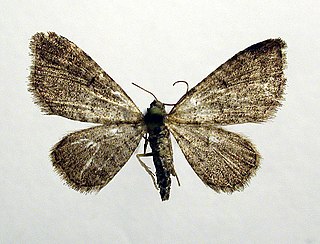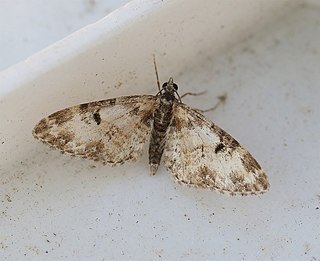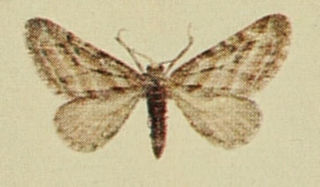
Eupithecia is the largest genus of moths of the family Geometridae, and the namesake and type genus of tribe Eupitheciini. Species in the genus are, like those of other genera in the tribe, commonly known as pugs. The genus is highly speciose, with over 1400 species, and members of the genus are present in most of the world with exception of Australasia. Roughly a quarter of described Eupithecia species occur in the Neotropical realm, where they have an especially high species diversity in the montane rain forests of the Andes. The genus includes a few agricultural pest species, such as the currant pug moth, Eupithecia assimilata, which is a pest on hops, and the cloaked pug moth, Eupithecia abietaria, which is a cone pest in spruce seed orchards.

The lime-speck pug is a moth of the family Geometridae. It is a common species throughout the Palearctic region, the Near East and North Africa.

The grey pug is a moth of the family Geometridae. It is found throughout the Palearctic region. It is also found in North America. Since it does not place any special demands on climatic conditions, special caterpillar food plants, geological subsoil or the like it is a typical species of almost any Hochstaudenflur, where it occurs in the herb layer, in bushes and even on deciduous trees. It can be found on forest edges and hedgerows, on heath, in rocky places and wetlands, parks and gardens, as well as in villages and town centres.

The tawny speckled pug is a moth of the family Geometridae.

The goldenrod pug is a moth of the family Geometridae. The species was first described by Henry Doubleday in 1861. It is found throughout the Palearctic region. In the British Isles it is widespread but rather locally distributed.

The juniper pug or juniper looper is a moth of the family Geometridae. The species was first described by Michael Denis and Ignaz Schiffermüller in 1775. It is found throughout the Palearctic and in the Nearctic.

Eupithecia plumbeolata, the lead-coloured pug, is a moth of the family Geometridae. The species can be found all over Europe ranging to the Urals, then through Central Asia to Siberia and to Sayan mountains, the Altai and the Amur. In the Alps, the species occurs up 2000 metres above sea level and in the Pyrenees up to in 2400 metres.

Eupithecia irriguata, the marbled pug, is a moth of the family Geometridae. The species can be found in Europe and North Africa.

Eupithecia insigniata, the pinion-spotted pug, is a moth of the family Geometridae. The species can be found in Europe and Turkey.

Eupithecia dodoneata, the oak-tree pug, is a moth of the family Geometridae. The species can be found in Europe. Local occurrences are found in Asia Minor, the Caucasus as well as in Morocco. In the Pyrenees and the Alps, it rises to altitudes of 1000 metres. The species prefers dry oak and oak mixed forests.

Eupithecia venosata, the netted pug, is a moth of the family Geometridae, first described by the Danish zoologist Johan Christian Fabricius in 1787. It is found across the Palearctic realm from Portugal and Morocco in the west to the Lake Baikal in Siberia and Afghanistan and Pakistan in the east.

Xestia dilucida, the dull reddish dart or reddish heath dart, is a moth of the family Noctuidae. The species was first described by Herbert Knowles Morrison in 1875. It is found in the United States from southern Maine to northern Florida, west to central Ohio and eastern Texas.

Eupithecia satyrata, the satyr pug, is a species of moth of the family Geometridae. It was described by Jacob Hübner in 1813. It is found from Ireland, through northern and central Europe east to all of Russia and central Asia and western Siberia to Tibet. It is also present in North Africa and North America.

Eupithecia analoga is a moth of the family Geometridae. The species can be found from western Europe to the Ural and Siberia. In the north, the range extends north of the polar circle. South, it is found up to the Alps.

Eupithecia distinctaria, the thyme pug, is a moth of the family Geometridae. It is found throughout Europe. It is also found in Iran. from the Iberian Peninsula through western and central Europe including the British Isles as well as further east as far east as far as Russia and Iran. In the north the range reaches as far as the southern Fennoscandia, to the south, where it is more common, it occupies the Mediterranean and Asia Minor. It is found primarily on warm, stony slopes and rocky structures as well as on sparse grassy areas with thyme mounds. In the Alps, it rises to heights of 2000 metres.

Eupithecia extensaria, the scarce pug, is a moth of the family Geometridae. The species was first described by Christian Friedrich Freyer in 1844. It is found in the British Isles, Spain and eastern Europe.

Eupithecia ericeata is a moth in the family Geometridae first described by Jules Pierre Rambur in 1833. It is found in most of southern Europe and the Near East.
Idalus dilucida is a moth of the family Erebidae. It was described by Walter Rothschild in 1910. It is found in Peru.
Metamesia dilucida is a species of moth of the family Tortricidae. It is found on Madagascar.
















